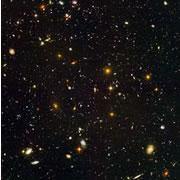 Why is the energy pushing apart the Universe so small? Maybe because it's much older than we thought.© NASA
Why is the energy pushing apart the Universe so small? Maybe because it's much older than we thought.© NASAA bouncing universe that expands and then shrinks every trillion years or so could explain one of the most puzzling problems in cosmology: how we can exist at all.
If this explanation, proposed in Science1 by Paul Steinhardt at Princeton University, New Jersey, and Neil Turok at the University of Cambridge, UK, seems slightly preposterous, that can't really be held against it. Astronomical observations over the past decade have shown that "we live in a preposterous universe", says cosmologist Sean Carroll of the University of Chicago. "It's our job to make sense of it," he says.
In Steinhardt and Turok's cyclic model of the Universe, it expands and contracts repeatedly over timescales that make the 13.7 billion years that have passed since the Big Bang seem a mere blink. This makes the Universe vastly old. And that in turn means that the mysterious 'cosmological constant', which describes how empty space appears to repel itself, has had time to shrink into the strangely small number that we observe today.
Cosmic disagreement
In 1996, it was discovered that the universe is not only expanding but is also speeding up. The cosmological constant was used to describe a force of repulsion that might cause this acceleration. But physicists were baffled as to why the cosmological constant was so small.
Quantum theory suggests that 'empty' space is in fact buzzing with subatomic particles that constantly pop in and out of existence. This produces a 'vacuum energy', which makes space repel itself, providing a physical explanation for the cosmological constant.
But the theoretically calculated value of vacuum energy is enormous, making space far too repulsive for particles to come together and form atoms, stars, planets, or life. The observed vacuum energy, in contrast, is smaller by a factor of 10120 - 1 followed by 120 zeros. "It is a huge problem why the vacuum energy is so much smaller than its natural value," says Carroll.
You're special
“We live in a preposterous universe.”
Sean Carroll,
University of Chicago.
One of the favoured explanations is the 'anthropic principle'. This suggests that in the apparently infinite Universe, the cosmological constant varies from place to place, taking on all possible values. So there's bound to be at least one region where it has the right size for galaxies and life to exist - and that's just where we are, puzzling over why our observable Universe seems so 'special'.
But this runs against the grain for physicists, who prefer to be able to explain our Universe in one shot. "Relying on the anthropic principle is like stepping on quicksand," Steinhardt and Turok write. They think they have a more satisfying explanation.
They have seized on an idea first proposed by physicist Larry Abbott in 1985: that maybe the vacuum energy was once big but has declined to ever smaller values. Abbott showed that this decay of the vacuum energy would proceed through a series of jumps, with each jump taking exponentially longer than the last. Over time, the Universe would spend far longer in states with a vacuum energy close to zero than with a high vacuum energy.
A long, long time ago
The problem was that Abbott's calculations implied that by the time the vacuum energy decayed to very small values, the expansion of space would have diluted all the matter within it so much that it would effectively be empty.
The cyclic universe gets around this problem, say Steinhardt and Turok. With cycles of growth and collapse taking a trillion years or so, and no limit to how many such cycles have preceded ours, there is plenty of time for the vacuum energy to have decayed almost to zero. And each cycle would concentrate matter during the collapse phase, making sure that the Universe doesn't end up empty.
Steinhardt and Turok say that their idea is testable. The cyclic model predicts that the Big Bang induces gravity waves in space, which physicists are now hunting for. And the decay of the vacuum energy predicts new types of fundamental particles called axions, which may also be detectable.
ADVERTISEMENT
"It's an interesting idea," says Carroll. He confesses that he has other worries about the cyclic-universe model that temper his enthusiasm. But the wackiness of it doesn't bother him. "Any explanation is quite likely to be extreme," he says, "because all the non-extreme possibilities have already been thoroughly explored."
Visit our universecould_explain.html">newsblog to read and post comments about this story.
University of Chicago.
